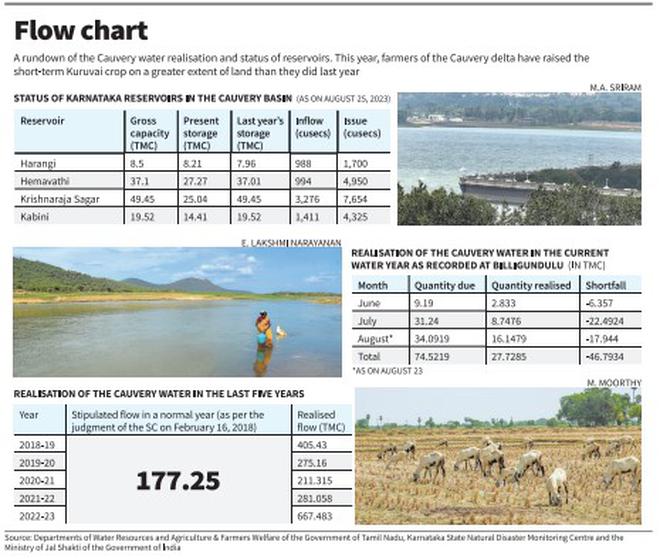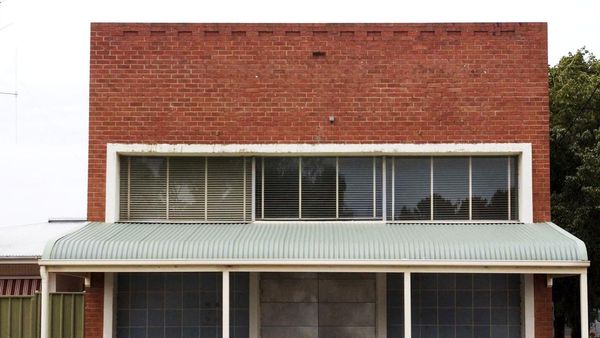Cauvery delta farmers are keeping their fingers crossed. They have raised the short-term Kuruvai crop on a greater extent of land than they did last year. The bounty of the Cauvery, evident during the southwest monsoon of 2022, along with a moderate northeast monsoon, must have given them the hope that this time, too, they could benefit from nature. “Besides, the government, I mean the State Agriculture Department, had encouraged the farmers to go in for Kuruvai,” says a former official of the department in Tiruvarur district, who has made Tiruvarur district his home after retirement, despite hailing from a place several hundred kilometres away.
According to Volume V of the final award of the Cauvery Water Disputes Tribunal, the delta in Tamil Nadu raises three varieties of paddy — Kuruvai, lasting 105 days between June and October; Thaladi, raised for 165 days, from October to February, in the places where Kuruvai gets harvested; and the long-term, Samba, for 180 days, beginning with transplantation in July and ending with harvest in mid-January, coinciding with the Pongal festival in the Tamil month of Thai.
As of now, neither farmers’ representatives nor officials nor independent observers have received reports of the Kuruvai crop withering. However, AIADMK general secretary Edappadi K. Palaniswami claimed in a statement on August 26 that the crop had withered in some villages of Thalainayar block in Nagapattinam. “In fact, a section of farmers, after observing poor or no flow of water, destroyed the crop that showed signs of stunted growth. I would say a considerable number of farmers did it,” says V. Sathyanarayanan, general secretary, Consortium of Cauvery Delta Farmers, Tiruvarur, who skipped Kuruvai this time.
Precarious situation
However, the former Agriculture Department official says, “It is a precarious situation. If this continues, it will be difficult for the crop to survive.” According to an estimate, done by P.R. Pandian of the Tamil Nadu Federation of All Farmers’ Associations, out of about 5.6 lakh acres planted during Kuruvai this time, borewells (groundwater) meet the needs of 1.25 lakh acres. “We are confident of protecting another 1.5 lakh acres,” he says. In the assessment of Arupathy Kalyanam, general secretary, Federation of Farmers Associations, Cauvery Delta Districts, “The State may have to sacrifice two lakh acres for want of water. You can expect harvest from around three lakh acres.” According to the data furnished by the department, the crop was harvested, as on August 21, on about 73,000 acres, of which Thanjavur accounted for 80%.

The macro situation delivers one message: time is running out, unless a “miracle” happens, as C. Ramasamy, former Vice-Chancellor of Tamil Nadu Agricultural University (TNAU), puts it. He indicates that certain areas under Kuruvai may have to be abandoned, as the focus hereafter should be on Samba. As on August 25, the storage in the Mettur dam, the lifeline of the delta, was 21.044 thousand million cubic feet (tmc). After allowing 10 tmc for dead storage and drinking water supplies, what is left is 11 tmc, which can last for nearly 28 days, only if the inflow and the discharge (as recorded on August 25) continue. The inflow was around 0.48 tmc, whereas the discharge was 0.86 tmc. The moot question is whether one can make such an assumption. “September is only a few days away. The southwest monsoon is almost over,” points out Mr. Ramasamy. No one denies that the entire Cauvery basin is in distress. From June 1 to August 25, Kodagu district, where the Cauvery originates, recorded a deficit rainfall of 47%, says a report of the meteorological department. A 26-page affidavit that the Karnataka government filed before the Supreme Court and was made public on August 24 stated that the catchments of the Krishnaraja Sagar (the biggest dam in that State across the river) recorded 23% less rainfall and those of the Kabini dam (named after the river which rises in Kerala’s north Wayanad), 22% less.
Supply for Samba crop
But what Tamil Nadu is concerned about is the supply to be made available for the Samba crop. “At present, we, at Mettur, are releasing around 10,000 cubic feet per second [cusecs] and receiving about 6,000 cusecs. While in the coming days we may get much less than what we are getting, we cannot reduce our discharge for irrigation below 8,000 cusecs,” explains an official.
He adds that the transplantation for Samba has not yet taken place and when it happens, more water has to be released. As of now, according to the data of the Agriculture Department, the nursery has been prepared in the delta for 880 acres (which may help to transplant the crop on nearly 27,000 acres), while direct sowing has been resorted to in 4,150 acres. What should not be overlooked is that while this year’s Kuruvai coverage is around 5.6 lakh acres, the extent of Samba, as approved by the Tribunal, is 18.56 lakh acres. But the present Mettur dam storage is not a matter of comfort to anyone. If the Cauvery catchments, be it in Karnataka or Kerala, do not receive heavy rainfall in the coming weeks, Tamil Nadu farmers will have to depend only on the graces of nature — in the form of rainfall during the northeast monsoon (October-December).
Even as the legal battle is on for securing the State’s rightful share of water, there is a view among the farmers that the authorities could have been more cautious before starting water release from the Mettur dam on June 12, the scheduled date. Mr. Pandian complains that “there was not much planning beforehand. Also, there were not much consultations with the farmers.” He wants the government to hold an all-party meeting and insists that farmers’ bodies be invited to it, as the government should get non-partisan and farmers’ inputs. Mr. Sathyanarayanan alleges, “I doubt whether any consideration was given to the availability of water in the Karnataka reservoirs and the anticipated inflows in the initial phase of the southwest monsoon.”
However, another official justifies the decision. Apart from the dam having the storage of 69.252 tmc on June 12, the meteorological department’s forecast of 106% of Long Period Average (LPA) for the southern peninsula was taken into account. “Historically too, whenever the storage in the dam was about 50 tmc, water was released for irrigation on June 12. This is a time-tested and age-old practice,” the official points out. The preparatory work — the upkeep of the distribution system and silt clearance — was done during the non-irrigation season. It was completed before the dam was opened to ensure that the tail-end of the delta, too, received water.
‘Systematic desilting’
Since 2021, a “systematic desilting” was done every year in around 5,000 km of rivers and channels belonging to classes of A and B and the Water Resources Department. The exercise also covered thousands of km in the C and D channels coming under the Rural Development Department, the official says, adding that the water reached the tail-end of the system “within the shortest time possible”.
The present situation has triggered a debate on the advisability of providing Mettur water for the Kuruvai crop. “You can have a flexible approach. Samba should be our top priority,” says K.V. Elankeeran, president of the Cauvery Delta Farmers’ Association, who hails from Kattumannarkoil in Cuddalore and who did not raise Kuruvai this year. But the former Agriculture Department official says that though only those farmers having access to groundwater raise the short-term crop, traditionally, there is also an economic element. “They would like to have money at the time of Deepavali. For all practical purposes, it is like a commercial crop,” the official adds.
Mr. Pandian says the Tribunal, while deciding on Tamil Nadu’s water requirements, allotted water for about 1.85 lakh acres of Kuruvai and Thaladi. “So, you cannot ignore Kuruvai altogether,” he underscores, adding that food security will also be affected. Of course, all those who defend the short-term crop are not oblivious to the larger benefits that Samba yields: food security and livelihood opportunities to lakhs of farmers, especially landless labourers.
There is also criticism that the State government has not arranged insurance coverage, under the Pradhan Mantri Fasal Bima Yojana, for Kuruvai. But a senior official of the Agriculture Department says that though there has been no coverage for the last couple of years, the government would always be willing to compensate farmers for crop loss under the disaster response fund schemes. Mr. Kalyanam suggests that the Centre launch an incentive-linked crop insurance scheme, which will assure all enrolled farmers of a minimum of 20% as the base claim (to be contributed equally by the Union and State governments). Despite the steps to protect the farmers, the importance of the preservation and conservation of water resources remains significant. “There is enormous scope still available in this regard. We have to approach this matter scientifically and in a sustained manner,” emphasises K. Ramasamy, another former Vice-Chancellor of TNAU. The delta should feature prominently in any new scheme of the government, Central or State. Successful implementation of the scheme would make the farmers less vulnerable in distress years in future.







